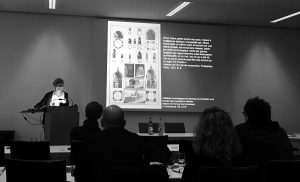Lehrmedien der Kunstgeschichte (22.-24. November 2018) – media in the teaching of art history
conference organised by German Documentation Center for Art History (DDK) – Bildarchiv Foto Marburg, Prof. Dr. Hubrt Locher, Dr. Maria Männig, book of abstracts

“Art historiography is an integral part and the subject of art historical research. Moreover, since the 1970s, there has been growing interest in the specific configurations of different media in art history.” – since my own research on the arthistorical discourse between 1850 and 1935 in Germany, Poland and Czech Republic concentrates on the representation of architectural monuments in illustrated volumes and collections of architectural models, the conference in Marburg was a high valued source of information and fruitful discussion for me.
“The Marburg conference would like to make first attempt at systematising these efforts by formulating the key ideas for providing a firm media-theoretical basis for the research area ‘history of art history’. […] The international conference, at the outset, will be directed at the academic discourse of the discipline, but will also widen the focus to the philosophical, archaeological, and media-studies perspective, seeking to gain an understanding of the bounderies and the limits of art historical educational practices.” – the aim of the conference was, as this quote shows, a very foundational and ambitional one. As I understand todays discourse on media of art history, I agree, that the theoretical basis on this subject is not fully developed. The conference shed light on the different approaches and was a welcomed opportunity to discuss and exchange ideas. The guests from Germany, the US, Italy, the Netherlands or Greece are working on a wide range of project broadly concerning the history of art history. Nevertheless, most of the talks and presentations focused on the discourse of the early 20th century, therefore, analysing photography in school books or manuals, slide projections and photographic archives. Since the conference took place in Marburg and was organized by the DDK and Foto Marburg we were able to visit their collection. The tour through the storages provided an interesting insight in the collection’s history, its condition and scope. Especially the cardboards that were used for teaching art history and the collection of glas slides by Richardt Hamann (1879-1961) and Franz Stoedtner (1870-1946) made me think about widening my research corpus to slide projections, slide catalogues and teaching material like cardboards. They illustrate the aim to construct art history along images and reproductions of architectural monuments by all means: Often they are grouped around stilistic catagories or national affiliations.
Robert Nelson in his keynote lecture on slide lectures called in mind the difference between reproduction (re – production) and representation (re – presentation), which I consider very confincing and important to remember. In addition, he pointed out, that arrangements of images on (powerpoint) slides are connected to presentation practices in museums. He even analysed VR models and reconstructions that become increasingly popular, as spaces connecting knowledge and participatory experience.
Naturally the keynote lecture by Gottfried Boehm was a special highlight. He talked about the ‘Eigensinn der Bilder’ (images own sense/meaning) and accentuated – in comparison to our discussions about reproductions and representations – the power of the artwork itself.

Prof. Daniela Mondini – to my great joy – focused on techniques of montage in arthistorical practice. In the lecture she reflected on her analyses of Séroux d’Agincourts ‘l’histoire de l’art par les monumens’ (1823) and drawed the bow to todays powerpoint presentations. It really is an honour for me, that she is the supervisor of my PhD research project. Several times in this lecture and during other contributions on the last conference day the connection to and the understanding of illustrated volumes and other media in the teaching of art history as museums were discussed. This approach interests me greatly, as it was also the closing argument of my master thesis in art history.
I am very thankful for the opportunity to participate in this conference and highly motivated to continue with my own research, which will shed light on a rather unknown field: the arthistorical discourse in Middle and Eastern Europe.
Learn more about the conference online.
